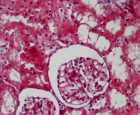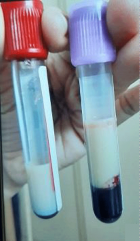Abstract
Research Article
Dietary and Lifestyles assessment among Obese Women in Gaza City, Palestine
Marwan O Jalambo*, Basil Kanoa, Mohammed S Ellulu, Smaher Younis and Mueen El-Kariri
Published: 04 December, 2018 | Volume 2 - Issue 1 | Pages: 017-025
Background: The fundamental cause of obesity and overweight is an energy imbalance between calories consumed and calories expended.
Aim: To clarify and figure out food habits and different lifestyle pattern among a sample of Palestinian women attending the nutrition center in the Gaza Strip.
Methods: A cross-sectional study involved 116 women were randomly chosen by purposive census sampling. They aged 25 to 60 years with a diagnosis of obesity. The data collected by interview questionnaire that included social factors, lifestyle habits, and health/disease history.
Results: Age group variable has distributed significantly (p=0.024), (31.0%) of morbid obese were ≥35 years group compared to (13.5%) of morbid obese amongst the younger group. The higher intakes of legumes (OR: 2.134, P=0.003), nuts (OR: 3.917, P=0.019), eggs (OR: 6.840, P=0.009), fast foods (OR: 4.461, P=0.005), and soda drinks (OR: 2.230, P=0.004) were the risk factors linked to the increased risk of morbid obesity. Moreover, the higher intakes of legumes (OR: 8.439, P=0.011), eggs (OR: 6.900, P=0.041), chips (OR: 5.049, P=0.012), sugar (OR: 2.068, P=0.011), and fast foods (OR: 3.029, P=0.025) are risk factors of chronic diseases.
Conclusion: The study identified several lifestyle factors and improper dietary habits associated with obesity among women in Gaza city. There is a great need to change these habits to avoid the increased risk of obesity. Gene-environment interaction can explain the high incidence of obesity. A national plan of action to overcome obesity is urgently needed to reduce its economic and health burden
Read Full Article HTML DOI: 10.29328/journal.niogb.1001009 Cite this Article Read Full Article PDF
References
- Gonçalves JT, Silveira MF, Campos MC, Costa LH. Overweight and obesity and factors associated with menopause. Ciencia & saude coletiva. 2016; 21: 1145-1156. Ref.: https://goo.gl/SWb4VB
- Hassan NE, Wahba SA, El-Masry SA, Elhamid ER, Boseila SA, et al. Eating Habits and Lifestyles among a Sample of Obese Working Egyptian Women. Open Access Maced J Med Sci. 2015; 3: 12-17. Ref.: https://goo.gl/hm8Dxf
- Popkin BM. The nutrition transition and obesity in the developing world. J Nutr. 2001; 131: 871S-873S. Ref.: https://goo.gl/8msHxs
- Eckel RH, York DA, Rössner S, Hubbard V, Caterson I, et al. prevention conference VII. Obesity, a worldwide epidemic related to heart disease and stroke: executive summary. Circulation. 2004; 110: 2968-2975. Ref.: https://goo.gl/kRAZJ2
- Hill JO, Peters JC. Environmental contributions to the obesity epidemic. Science. 1998; 280: 1371-1374. Ref.: https://goo.gl/kRAZJ2
- Popkin BM, Doak CM. The obesity epidemic is a worldwide phenomenon. Nutrition reviews. 1998; 56: 106-114. Ref.: https://goo.gl/tCvevJ
- Giles-Corti B, Macintyre S, Clarkson JP, Pikora T, Donovan RJ. Environmental and lifestyle factors associated with overweight and obesity in Perth, Australia. Am J Health Promot. 2003; 18: 93-102. Ref.: https://goo.gl/SXHUU7
- Kanoa BJ, Abu-Nada OS, El-Sakka MA. Weight Reduction Perception and Practice among Female Students in Al-Azhar University-Gaza, Palestine. Turkish Journal of Public Health. 2008; 6: 47. Ref.: https://goo.gl/ECT43j
- Merchant AT, Dehghan M, Behnke-Cook D, Anand SS. Diet, physical activity, and adiposity in children in poor and rich neighbourhoods: a cross-sectional comparison. Nutr J. 2007; 6: 1. Ref.: https://goo.gl/fKP6xy
- Rodríguez-Martín A, Novalbos Ruiz JP, Martínez Nieto JM, Escobar Jiménez L. Life-style factors associated with overweight and obesity among Spanish adults. Nutr Hosp. 2009; 24: 144-151. Ref.: https://goo.gl/NJbpZC
- Abrantes MM, Lamounier JA, Colosimo EA. Overweight and obesity prevalence in Northeast and Southeast Regions of Brazil. Rev Assoc Med Bras. 2003; 49: 162-166. Ref.: https://goo.gl/A69U7q
- Prentice AM, Jebb SA. Fast foods, energy density and obesity: a possible mechanistic link. Obes Rev. 2003; 4: 187-194. Ref.: https://goo.gl/aMfSXi
- Koh-Banerjee P, Chu NF, Spiegelman D, Rosner B, Colditz G, et al. Prospective study of the association of changes in dietary intake, physical activity, alcohol consumption, and smoking with 9-y gain in waist circumference among 16 587 US men. Am J Clin Nutr. 2003; 78: 719-727. Ref.: https://goo.gl/8j6xjR
- Gutiérrez-Fisac JL, Banegas Banegas JR, Artalejo FR, Regidor E. Increasing prevalence of overweight and obesity among Spanish adults, 1987–1997. Int J Obes Relat Metab Disord. 2000; 24: 1677. Ref.: https://goo.gl/aCsFUq
- Rodríguez Artalejo F, López García E, Gutiérrez-Fisac JL, Banegas Banegas JR, Lafuente Urdinguio PJ, et al. Changes in the prevalence of overweight and obesity and their risk factors in Spain, 1987–1997. Prev Med. 2002; 34: 72-81. Ref.: https://goo.gl/P5TtsM
- Petersen L, Schnohr P, Sørensen TI. Longitudinal study of the long-term relation between physical activity and obesity in adults. Int J Obes Relat Metab Disord. 2004; 28: 105. Ref.: https://goo.gl/CN7Bk2
- Katzmarzyk PT, Janssen I, Ardern CI. Physical inactivity, excess adiposity and premature mortality. Obesity reviews. 2003; 4: 257-290. Ref.: https://goo.gl/eW8vPP
- Akbartabartoori M1, Lean ME, Hankey CR. The associations between current recommendation for physical activity and cardiovascular risks associated with obesity. Eur J Clin Nutr. 2008; 62: 1. Ref.: https://goo.gl/JGHEor
- Global strategy on diet, physical activity and health. 2004; Ref.: https://goo.gl/W2thzP
- Tohill BC. Dietary intake of fruit and vegetables and management of body weight. 2005; WHO. Ref.: https://goo.gl/oCJxqH
- Ledoux TA, Hingle MD, Baranowski T. Relationship of fruit and vegetable intake with adiposity: a systematic review. Obes Rev. 2011; 12: Ref.: https://goo.gl/iogKKA
- Abudayya AH, Stigum H, Shi Z, Abed Y, Holmboe-Ottesen G. Sociodemographic correlates of food habits among school adolescents (12–15 year) in North Gaza Strip. BMC Public Health. 2009; 9: 185. Ref.: https://goo.gl/y5TaLr
- Musaiger A. Food consumption patterns in the Eastern Mediterranean Region. Food consumption patterns in the Eastern Mediterranean Region. 2011; Ref.: https://goo.gl/NE2RGP
- Niemeier HM, Raynor HA, Lloyd-Richardson EE, Rogers ML, Wing RR. Fast food consumption and breakfast skipping: predictors of weight gain from adolescence to adulthood in a nationally representative sample. J Adolesc Health. 2006; 39: 842-849. Ref.: https://goo.gl/n6h1T7
- Shan XY, Xi B, Cheng H, Hou DQ, Wang Y, et al. Prevalence and behavioral risk factors of overweight and obesity among children aged 2–18 in Beijing, China. Int J Pediatr Obes. 2010; 5: 383-389. Ref.: https://goo.gl/qJocoQ
- Donma MM, Donma O. Beneficial Effects of Poultry Meat Consumption on Cardiovascular Health and the Prevention of Childhood Obesity. Med One. 2017; Ref.: https://goo.gl/p694QP
- Ibarrola-Jurado N, Bulló M, Guasch-Ferré M, Ros E, Martínez-González MA, et al. Cross-sectional assessment of nut consumption and obesity, metabolic syndrome and other cardiometabolic risk factors: the PREDIMED study. PloS one. 2013; 8: e57367. Ref.: https://goo.gl/msZRG2
- Flores-Mateo G, Rojas-Rueda D, Basora J, Ros E, Salas-Salvadó J. Nut intake and adiposity: meta-analysis of clinical trials–. The Am J Clin Nutr. 2013: 97: 1346-1355. Ref.: https://goo.gl/w6JCD8
- Sabaté J. Nut consumption and body weight. Am J Clin Nutr. 2003; 78: 647S-650S. Ref.: https://goo.gl/eiNfny
- Natoli S, McCoy P. A review of the evidence: nuts and body weight. Asia Pac J Clin Nutr. 2007; 16: 588-597. Ref.: https://goo.gl/SzXzqX
- Mihrete K. Association between fast food consumption and obesity and high blood pressure among office workers. 2011; Walden University. Ref.: https://goo.gl/sFGYSR
- Al-Haifi AR 1, Al-Fayez MA, Al-Athari BI, Al-Ajmi FA, Allafi AR, et al. Relative contribution of physical activity, sedentary behaviors, and dietary habits to the prevalence of obesity among Kuwaiti adolescents. Food Nutr Bull. 2013; 34: 6-13. Ref.: https://goo.gl/j5obBW
- Washi SA, Ageib MB. Poor diet quality and food habits are related to impaired nutritional status in 13-to 18-year-old adolescents in Jeddah. Nutr Res. 2010; 30: 527-534. Ref.: https://goo.gl/5VGtd7
- Andreyeva T, Kelly IR, Harris JL. Exposure to food advertising on television: associations with children's fast food and soft drink consumption and obesity. Econ Hum Biol. 2011; 9: 221-233. Ref.: https://goo.gl/V13tnv
- Fraser LK, Edwards KL, Cade JE, Clarke GP. Fast food, other food choices and body mass index in teenagers in the United Kingdom (ALSPAC): a structural equation modelling approach. Int J Obes (Lond). 2011; 35: 1325. Ref.: https://goo.gl/omq7BW
- Musaiger AO. Overweight and obesity in eastern mediterranean region: prevalence and possible causes. Journal of obesity. 2011; 2011: Article ID 407237. Ref.: https://goo.gl/9XpRCL
- Viuda-Serrano A, González-Millán C, Pérez-González B. Obesity Prevention through Physical Activity in School-Age Children and Adolescents. 2010, Retrieved 29/04/2012. Ref.: https://goo.gl/3DEpU1
- Martins ADS/ Atividade física, autoavaliação negativa de saúde e condutas de risco em adolescentes. 2017; Ref.: https://goo.gl/xkyurC
- Ellulu MS, Jalambo MO. Gene-environment interaction: The causes of high obesity incidence. Kathmandu Univ Med J. 2017; 57: 90-92. Ref.: https://goo.gl/tYzEZb
- Stevenson N. Family Environmental Characteristics Associated with Obesity in African American High School Girls. 2008; Ref.: https://goo.gl/ccdB9n
- Elinder LS1, Jansson M. Obesogenic enviromentsaspects on measurement and indicators. Public Health Nutrition. 2008; 12: 307-315. Ref.: https://goo.gl/S9cmXT
- Nielsen SJ, Popkin BM. Changes in beverage intake between 1977 and 2001. Am J Prev Med. 2004; 27: 205-210. Ref.: https://goo.gl/F6Vv2z
- Bray GA. Soft drink consumption and obesity: it is all about fructose. Curr Opin Lipidol. 2010; 21: 51-57. Ref.: https://goo.gl/hgvyBb
- Reducing consumption of sugar-sweetened beverages to reduce the risk of childhood overweight and obesity. 2015; Ref.: https://goo.gl/rBDYUa
Similar Articles
-
Hypoglycemia by Ginseng in type 2 Diabetic Patient: Case ReportAngelo Michele Carella*,Teresa Marinelli,Armando Melfitano,Michele Di Pumpo,Matteo Conte,Angelo Benvenuto. Hypoglycemia by Ginseng in type 2 Diabetic Patient: Case Report . . 2017 doi: 10.29328/journal.hodms.1001001; 1: 001-006
-
Cardiac Autonomic Modulation in children and Preadolescents obeseMário Augusto Paschoal*. Cardiac Autonomic Modulation in children and Preadolescents obese. . 2017 doi: 10.29328/journal.hodms.1001002; 1: 007-009
-
The interaction between photonic technology and physical exercise: The action of low-level laser therapyAntonio Eduardo de Aquino Jr*,Fernanda Mansano Carbinatto. The interaction between photonic technology and physical exercise: The action of low-level laser therapy. . 2017 doi: 10.29328/journal.hodms.1001003; 1: 010-013
-
Behavioral factors of Abdominal Obesity and effects of lifestyle changes with Fiber AdequacyRoberto Carlos Burini*,Hugo Tadashi Kano,Mariana Santoro Nakagaki,Patricia Baston Frenhani,Katia Cristina Portero-McLellan. Behavioral factors of Abdominal Obesity and effects of lifestyle changes with Fiber Adequacy. . 2017 doi: 10.29328/journal.hodms.1001004; 1: 014-022
-
Study of body composition, physiological variables in Grade III obese submitted to arm ergometer testRenato Vidal Linhares*,Felipe Monnerat Marino Rosa,José Quaresma,João Regis Ivar Carneiro,Valéria Bender Braulio,Roberto Simão,Denise Pires de Carvalho,osé Fernandes Filho. Study of body composition, physiological variables in Grade III obese submitted to arm ergometer test . . 2017 doi: 10.29328/journal.hodms.1001005; 1: 023-029
-
Upper gut bacterial overgrowth is a potential mechanism for Glucose Malabsorption after Vertical Sleeve GastrectomyTimothy R Koch*,Timothy R Shope,Matthew E Sharbaugh. Upper gut bacterial overgrowth is a potential mechanism for Glucose Malabsorption after Vertical Sleeve Gastrectomy. . 2017 doi: 10.29328/journal.hodms.1001006; 1: 030-035
-
Body mass index in a group of security forces (policemen). Cross-sectional studyGuillermo Padrón Arredondo*. Body mass index in a group of security forces (policemen). Cross-sectional study. . 2018 doi: 10.29328/journal.niogb.1001007; 2: 001-004
-
Herbal approach for obesity managementPreeti Singh*. Herbal approach for obesity management. . 2018 doi: 10.29328/journal.niogb.1001008; 2: 005-016
-
Dietary and Lifestyles assessment among Obese Women in Gaza City, PalestineMarwan O Jalambo*,Basil Kanoa,Mohammed S Ellulu,Smaher Younis,Mueen El-Kariri. Dietary and Lifestyles assessment among Obese Women in Gaza City, Palestine. . 2018 doi: 10.29328/journal.niogb.1001009; 2: 017-025
-
Obesity-Treatment by drugsSahithi G*. Obesity-Treatment by drugs. . 2019 doi: 10.29328/journal.niogb.1001010; 3: 001-001
Recently Viewed
-
The Accuracy of pHH3 in Meningioma Grading: A Single Institution StudyMansouri Nada1, Yaiche Rahma*, Takout Khouloud, Gargouri Faten, Tlili Karima, Rachdi Mohamed Amine, Ammar Hichem, Yedeas Dahmani, Radhouane Khaled, Chkili Ridha, Msakni Issam, Laabidi Besma. The Accuracy of pHH3 in Meningioma Grading: A Single Institution Study. Arch Pathol Clin Res. 2024: doi: 10.29328/journal.apcr.1001041; 8: 006-011
-
Assessment of Perceptions of Nursing Undergraduates towards Mental Health PracticesAlya Algamdii*. Assessment of Perceptions of Nursing Undergraduates towards Mental Health Practices. Clin J Nurs Care Pract. 2025: doi: 10.29328/journal.cjncp.1001059; 9: 007-011
-
Multipurpose Antioxidants based on Food Industry Waste: Production and Properties EvaluationToshkhodjaev*. Multipurpose Antioxidants based on Food Industry Waste: Production and Properties Evaluation. Arch Food Nutr Sci. 2025: doi: 10.29328/journal.afns.1001062; 9: 001-003
-
Relationship between Fertility Diet Score Index Items and Ovulation in Women with Polycystic Ovary Syndrome: A Narrative ReviewHadis Alimoradi,Faezeh Mashhadi,Ava Hemmat,Mohsen Nematy,Maryam Khosravi,Maryam Emadzadeh,Nayere Khadem Ghaebi,Fatemeh Roudi*. Relationship between Fertility Diet Score Index Items and Ovulation in Women with Polycystic Ovary Syndrome: A Narrative Review. Arch Food Nutr Sci. 2024: doi: 10.29328/journal.afns.1001061; 8: 041-048
-
Evaluation of the LumiraDx SARS-CoV-2 antigen assay for large-scale population testing in SenegalMoustapha Mbow*,Ibrahima Diallo,Mamadou Diouf,Marouba Cissé#,Moctar Gningue#,Aminata Mboup,Nafissatou Leye,Gora Lo,Yacine Amet Dia,Abdou Padane,Djibril Wade,Josephine Khady Badiane,Oumar Diop,Aminata Dia,Ambroise Ahouidi,Doudou George Massar Niang,Babacar Mbengue,Maguette Dème Sylla Niang,Papa Alassane Diaw,Tandakha Ndiaye Dieye,Badara Cisé,El Hadj Mamadou Mbaye,Alioune Dieye,Souleymane Mboup. Evaluation of the LumiraDx SARS-CoV-2 antigen assay for large-scale population testing in Senegal. Int J Clin Virol. 2022: doi: 10.29328/journal.ijcv.1001041; 6: 001-006
Most Viewed
-
Feasibility study of magnetic sensing for detecting single-neuron action potentialsDenis Tonini,Kai Wu,Renata Saha,Jian-Ping Wang*. Feasibility study of magnetic sensing for detecting single-neuron action potentials. Ann Biomed Sci Eng. 2022 doi: 10.29328/journal.abse.1001018; 6: 019-029
-
Evaluation of In vitro and Ex vivo Models for Studying the Effectiveness of Vaginal Drug Systems in Controlling Microbe Infections: A Systematic ReviewMohammad Hossein Karami*, Majid Abdouss*, Mandana Karami. Evaluation of In vitro and Ex vivo Models for Studying the Effectiveness of Vaginal Drug Systems in Controlling Microbe Infections: A Systematic Review. Clin J Obstet Gynecol. 2023 doi: 10.29328/journal.cjog.1001151; 6: 201-215
-
Prospective Coronavirus Liver Effects: Available KnowledgeAvishek Mandal*. Prospective Coronavirus Liver Effects: Available Knowledge. Ann Clin Gastroenterol Hepatol. 2023 doi: 10.29328/journal.acgh.1001039; 7: 001-010
-
Causal Link between Human Blood Metabolites and Asthma: An Investigation Using Mendelian RandomizationYong-Qing Zhu, Xiao-Yan Meng, Jing-Hua Yang*. Causal Link between Human Blood Metabolites and Asthma: An Investigation Using Mendelian Randomization. Arch Asthma Allergy Immunol. 2023 doi: 10.29328/journal.aaai.1001032; 7: 012-022
-
An algorithm to safely manage oral food challenge in an office-based setting for children with multiple food allergiesNathalie Cottel,Aïcha Dieme,Véronique Orcel,Yannick Chantran,Mélisande Bourgoin-Heck,Jocelyne Just. An algorithm to safely manage oral food challenge in an office-based setting for children with multiple food allergies. Arch Asthma Allergy Immunol. 2021 doi: 10.29328/journal.aaai.1001027; 5: 030-037

HSPI: We're glad you're here. Please click "create a new Query" if you are a new visitor to our website and need further information from us.
If you are already a member of our network and need to keep track of any developments regarding a question you have already submitted, click "take me to my Query."
















































































































































